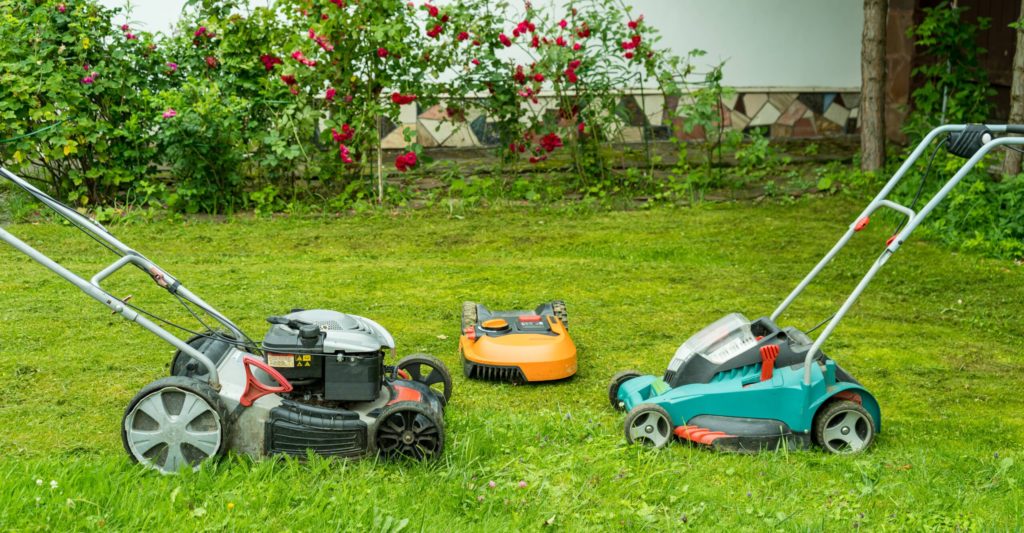- Free delivery over £195
- Delivery to UK & Ireland
- [email protected]
- 01366 500 828
- Manage my robot
What’s more, if you take on mowing the lawn as a manual task, the results are never quite as good or as consistent as expected. Mowing the lawn with a traditional lawn mower is difficult, especially when navigating the lumps and bumps of a standard garden.
Suffice to say, the comparison between an electric lawn mower and a robot lawn mower is not simply in the power source but in the user experience – namely how each mower is operated. Let’s take a closer look at the two different lawn mower types and how they differ.
There are different types of electric lawn mowers – some are corded and need to be plugged in, while others run on a battery.
The hallmark of electric lawn mowers, however, is that they are manually operated. That is, they require someone to push them back and forth across the lawn.
Both corded and cordless electric mowers have their benefits and potential challenges. Corded mowers are reliable in terms of their power and produce no carbon emissions, running on electricity instead of petrol or diesel fuel. As they are operated manually, you also have full control over when they are used and how you choose to mow your lawn – though the cord can impede on how much grass you can mow at any one time, due to the limit on length and stretch.
Cordless mowers work on a battery which provides complete freedom – and prevents your mowing area from being limited by the cable. Having said that, the battery life can be difficult to predict.
And don’t forget that even the most intuitive and long-lasting battery does not remove the simple fact that an electric mower has to be pushed around the garden or stretch of land by a human.
A robot lawn mower offers all the flexibility of a cordless electric mower but with a charging station that it can find by itself, and a built-in “brain” which connects directly to your smartphone app for remote management.
With a robot lawn mower, users simply need to set their mowing area, grass height, and density, and let the mower get to work. Intuitive by design, the mower will follow the pre-determined boundary laid out by a dug-in wire or RTK satellite technology and will return to its charging base once the task is complete.
Like electric mowers, robot mowers boast environmental credentials as well as a seamless user experience, with up to a 90% reduction in carbon emissions when compared with a traditional fuel-operated lawn mower. What’s more, robot mowers minimise damage to the ground and enable you to keep on top of grass height even after a particularly wet spell, mulching clippings back into the ground to promote healthy regrowth and reducing footfall and therefore compaction on the ground.
So, which is better – electric or robot?
Most consumers, grounds maintenance teams, and even homeowners and domestic gardeners would argue that robot mowers are the superior choice – if you are willing to invest in one.
Before we go into the reasons why robot mowers are so important, let’s address a major disadvantage of battery-operated mowers.
These cordless mowers are sometimes compared favourably to robot mowers – however, the difference is that a robot mower has a charging station which becomes the device’s base, while battery-operated mowers need to be charged or replaced manually and also require a user to get the job done. This adds two extra steps of human intervention where a robot mower requires none – making battery-operated mowers far less efficient than robot mowers.
The number one selling point of a robot lawn mower is that this is a device which requires little in the way of human intervention. Provided you lay the boundary wires in place or set the correct boundaries using RTK satellite technology, install a charging base, and minimise the presence of obstacles spread across your lawn or expanse of grass, a robot mower can and will manage itself.
What’s more, robot mowers can be programmed to cut the grass at a time which suits you – whether that be early in the morning, as the sun sets, or in the middle of the night.
A flexible addition to your workforce, robot mowers charge themselves by returning to their charging portal when not in use, with no need for human intervention or manual handling as an additional power source.
They are, by definition, smart enough to deliver all your lawn mowing needs on an automated schedule. And it’s this which makes them the preferred alternative to electric manual mowers for many buyers today.

Based in Norfolk and Suffolk, GroundTech supplies and installs commercial robot mowers and outdoor robotics across the UK. We support golf courses, sports clubs, schools, councils, large private estates and homeowners – backed by over 20 years of turf care and automation expertise.